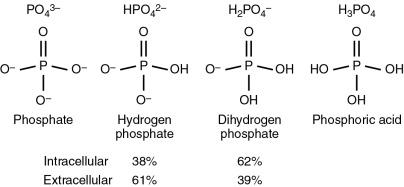Physical Address
304 North Cardinal St.
Dorchester Center, MA 02124
Phosphorus is a critical element in physiology. Phosphorus is an essential component of bone (hydroxyapatite), DNA, lipid membranes (phospholipids), signal molecules (phosphorylation activates numerous enzymes), and chemical energy storage (adenosine triphosphate and creatine phosphate). In the serum, phosphorus circulates as phosphate, PO 4 −3 usually with one or two protons, H 2 PO − 4 or HPO 4 2− ( Fig. 76.1 ).

The atomic weight of phosphorus is 31 g/mole and the average valence (pH 7.4) is 1.8. Normal serum phosphorus is 2.5 to 4.5 mg/dL. This converts to 0.8 to 1.45 mmol/L or 1.45 to 2.61 mEq/L.
There is 780 mg in a typical 70 kg man. Almost all of it (80% to 85%) is found in teeth and bones as hydroxyapatite. Only 0.1% is found in the extracellular fluid.
Organic phosphorus is found in meat, fish, dairy, whole grains, and nuts. However, most of the phosphorus we encounter in our diet is in the form of inorganic phosphorus added during food processing to enhance flavor and to improve color, and it serves as a preservative. Between 40% and 80% of dietary phosphorus is absorbed. The variability is largely due to the type of phosphorus consumed. Organic phosphorus is typically bound to proteins and must be metabolized to phosphate prior to absorption. Only about 40% to 60% of organic phosphorus is absorbed. Phosphate from animal protein is better absorbed than plant phosphate (phytate). Inorganic phosphate is more bioavailable, with as high as 90% absorption. The institute of medicine recommends 750 mg of phosphorus per day, with larger requirements (1250 mg/day) for children and pregnant women.
Food tables that list the phosphorus content do not include the phosphorus used as preservatives and so tend to underestimate daily phosphorus intake by as much as 272 to 350 mg.
Phosphate absorption in the gastrointestinal (GI) tract is largely unregulated, so increased dietary phosphate ingestion increases phosphate absorption. Active (1,25-OH) vitamin D also increases phosphate absorption.
The kidney filters between 3700 and 6100 mg of phosphate a day. Phosphate excretion is about 600 to 1500 mg/day, so about 75% to 85% of filtered phosphate is reabsorbed by the kidney. The proximal tubule reabsorbs about 85% of the filtered load via a triad of sodium-phosphate cotransporters (NaPi-2a, NaPi-2c, PiT-2). Phosphate reabsorption is regulated by numerous dietary, metabolic, and hormonal factors. Calculating the tubular reabsorption of phosphorous (TRphos) can provide insight into renal phosphorus handling. See Equation 76.1 .

Factors that lead to increased renal phosphate absorption include a low phosphate diet, 1,25-OH vitamin D, and thyroid hormone. On the other hand, parathyroid hormone (PTH), fibroblast growth factor (FGF)23, a high phosphate diet, metabolic acidosis, potassium deficiency, glucocorticoids, dopamine, hypertension, and estrogen lower phosphate absorption.
FGF-23 is classified as a phosphotonin—a hormone that increases urinary phosphorus. It is produced and released by osteocytes in response to increased serum phosphorus. When FGF-23 binds its receptor and the receptor’s co-factor, Klotho, it decreases phosphorus reabsorption in the proximal tubule. It also decreases 1-alpha hydroxylase, lowering 1,25-OH D levels. FGF-23 also can directly suppress PTH. Increases in FGF-23 are found early in chronic kidney disease (CKD) and is responsible for the decreased 1,25-OH D levels found in CKD. It helps maintain normal phosphate levels despite compromised glomerular filtration rate (GFR).
Phosphate depletion is a decrease in the total body soluble phosphate. Hypophosphatemia is a low serum phosphate level. Hypophosphatemia can be due to a decreased total phosphate level or to altered transcellular distribution of phosphorus into the intracellular compartment. Often, patients with phosphate depletion can maintain normal phosphate levels for a while, but are predisposed to sudden and acute drops in phosphate levels from events that shift phosphate into cells.
Become a Clinical Tree membership for Full access and enjoy Unlimited articles
If you are a member. Log in here